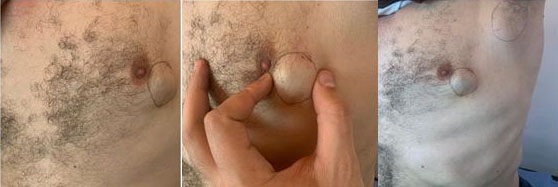 |
Research Article
Diagnostic spectrum of non-neoplastic ovarian lesions in Nigerians: A seven-year hospital-based retrospective study
1 FMCPath, Lecturer, Department of Anatomic Pathology and Forensic Medicine, Nile University of Nigeria, Abuja, Nigeria
2 FMCPath, Consultant Pathologist, Department of Anatomic Pathology and Forensic Medicine, Asokoro District Hospital, Abuja, Nigeria
3 FMCPath, Associate Professor/Head of Department, Department of Anatomic Pathology and Forensic Medicine, Nile University of Nigeria, Abuja, Nigeria
4 FWACS (O&G), Associate Professor, Department of Obstetrics and Gynecology, Nile University of Nigeria, Abuja, Nigeria
5 FWACS (O&G), Senior Lecturer, Department of Obstetrics and Gynecology, Nile University of Nigeria, Abuja, Nigeria
6 FWACP (Lab Med), Consultant Pathologist, Department of Anatomic Pathology, Diagnostic Pathology Consult Ltd, Abuja, Nigeria
Address correspondence to:
Bamnan Collins Dallang
Department of Anatomic Pathology and Forensic Medicine, Nile University of Nigeria, Abuja,
Nigeria
Message to Corresponding Author
Article ID: 100041G06BD2025
Access full text article on other devices

Access PDF of article on other devices

How to cite this article
Dallang BC, Okwudire-Ejeh IA, Ezike KN, Mai AM, Asaolu OA, Kwari SD, Adeoye AO, Oguntebi EE. Diagnostic spectrum of non-neoplastic ovarian lesions in Nigerians: A seven-year hospital-based retrospective study. Edorium J Gynecol Obstet 2025;10(1):6–14.ABSTRACT
Aims: Ovarian lesions are an important cause of morbidity and mortality worldwide. They are classified as non-neoplastic, neoplastic, and inflammatory. Non-neoplastic lesions occur most frequently. This study aims to describe the diagnostic spectrum of non-neoplastic ovarian lesions in a Nigerian population and compare their frequency, diagnoses, and clinical presentations with other studies from Nigerian and other regions of the world.
Methods: This was a hospital-based retrospective descriptive study of histologically diagnosed non-neoplastic lesions of the ovary.
Results: About 42.8% (295/689) of the ovarian lesions that met the inclusion criteria were non-neoplastic. The age range of the patients was 15–70 years. The median age was 34 years. The 25–34 years age range, 41.0% (121/295), had the highest frequency, while the 55–64 years age range, 0.7% (2/295), was least. Common clinical features included abdominal pain, 81/295 (27.5%), menstrual abnormalities 74/295 (25.1%), and abdominal swelling 67/295 (22.7%). The diagnostic spectrum included cystic, solid, and inflammatory lesions. Corpus luteum cysts, 49.5% (146/295), were the most frequent, followed by follicular cysts, 28.1% (83/295). Polycystic ovary syndrome (PCOS), 0.7% (2/295), was the least encountered cystic lesion. Majority of the specimens, 41.0% (121/295), were small (<5 cm dimension), while the large (>15 cm), 13.9% (41/295), were least frequent.
Conclusion: Non-neoplastic ovarian lesions are an important cause of morbidity in the study population, with corpus luteum cyst as the commonest. Nulliparous and low parity patients were the most frequently affected. Timely and accurate histological recognition of these lesions are important for the purpose of institution of proper treatment.
Keywords: Corpus luteum cyst, Follicular cyst, Nigeria, Non-neoplastic, Ovary
SUPPORTING INFORMATION
Acknowledgments
The authors wish to thank Mr. Alex Adeyemo, data analyst and statistician with the University of Abuja, Gwagwalada, Abuja, Nigeria, for his assistance with the data analysis. All relevant data are available upon reasonable request.
Author ContributionsBamnan Collins Dallang - Substantial contributions to conception and design, Acquisition of data, Analysis of data, Interpretation of data, Drafting the article, Revising it critically for important intellectual content, Final approval of the version to be published
Ijeoma Ahunna Okwudire-Ejeh - Substantial contributions to conception and design, Acquisition of data, Analysis of data, Interpretation of data, Drafting the article, Revising it critically for important intellectual content, Final approval of the version to be published
Kevin Nwabueze Ezike - Analysis of data, Interpretation of data, Revising it critically for important intellectual content, Final approval of the version to be published
Aminu M Mai - Analysis of data, Interpretation of data, Revising it critically for important intellectual content, Final approval of the version to be published
Oluseyi A Asaolu - Analysis of data, Interpretation of data, Revising it critically for important intellectual content, Final approval of the version to be published
Shiktira D Kwari - Analysis of data, Interpretation of data, Revising it critically for important intellectual content, Final approval of the version to be published
Adewunmi Oluseye Adeoye - Analysis of data, Interpretation of data, Revising it critically for important intellectual content, Final approval of the version to be published
Emmanuel Eyitayo Oguntebi - Acquisition of data, Interpretation of data, Revising it critically for important intellectual content, Final approval of the version to be published
Guaranter of SubmissionThe corresponding author is the guarantor of submission.
Source of SupportNone
Consent StatementWritten informed consent was obtained from the patient for publication of this article.
Data AvailabilityAll relevant data are within the paper and its Supporting Information files.
Conflict of InterestAuthors declare no conflict of interest.
Copyright© 2025 Bamnan Collins Dallang et al. This article is distributed under the terms of Creative Commons Attribution License which permits unrestricted use, distribution and reproduction in any medium provided the original author(s) and original publisher are properly credited. Please see the copyright policy on the journal website for more information.





